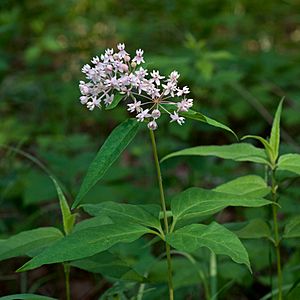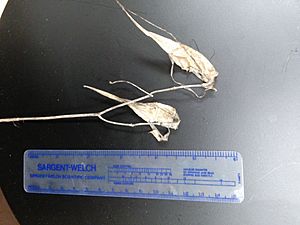Four-leaved milkweed facts for kids
Quick facts for kids Four-leaved milkweed |
|
|---|---|
 |
|
| Conservation status | |
| Scientific classification | |
| Genus: |
Asclepias
|
| Species: |
quadrifolia
|
Asclepias quadrifolia, also known as fourleaf milkweed or whorled milkweed, is a special plant. It is a type of milkweed that grows in the eastern parts of the United States and Canada. This plant is known for its unique leaves and pretty flowers.
Contents
What Does Fourleaf Milkweed Look Like?
Fourleaf milkweed is a perennial herb. This means it's a plant that lives for more than two years. It grows back each year from a thick underground stem called a rhizome. This plant is quite small and thin compared to other milkweeds. It usually grows to about 45 centimeters (18 inches) tall.
Leaves and Flowers
The leaves of the fourleaf milkweed are usually oval-shaped. They are arranged opposite each other on the stem. However, they often grow very close together. This makes them look like a "false whorl" or a circle of leaves around the stem. Each leaf can be from 2.5 to 12 centimeters long and 1 to 6 centimeters wide.
The flowers are a pale pink to white color. They grow in round clusters that often hang downwards. These clusters can be found where the leaves meet the stem (called leaf axils) or at the very top of the plant.
Fruits and Seeds
After the flowers bloom, the plant produces a fruit called a follicle, or pod. These pods are very slender, about 8 to 14 centimeters (3.2 to 5.6 inches) long. They are smooth or have tiny hairs. Inside the pods are broadly oval seeds. Each seed is about 1/3 inch long and has a tuft of white to tan hairs at one end. These hairs help the seeds float away in the wind.
Where Does Fourleaf Milkweed Grow?
Unlike some other well-known milkweed types, fourleaf milkweed prefers to live in woodlands. You can often find it in dry, rocky forests that are open and sunny. It especially likes to grow on slopes in higher areas.
Who Visits Fourleaf Milkweed?
Fourleaf milkweed is an important plant for many insects. These insects visit the plant to drink its sweet nectar. Some of the visitors include bumblebees and other types of bees. You might also see wasps, ants, flies, and many different butterflies enjoying the nectar.
Monarch Butterfly Connection
One of the most famous visitors to milkweed plants is the monarch butterfly. The caterpillars of the monarch butterfly eat the leaves of milkweed plants, including fourleaf milkweed. This is very important for their growth and development.
Is Fourleaf Milkweed Safe?
Most Asclepias plants, including fourleaf milkweed, contain special chemicals. These chemicals are called cardiac glycosides. If a large amount of the plant is eaten, these chemicals can be harmful. It's always best to admire wild plants without touching or eating them.
Growing Fourleaf Milkweed
Fourleaf milkweed is not very common in gardens or cultivated areas. It prefers to grow in its natural woodland habitat.



